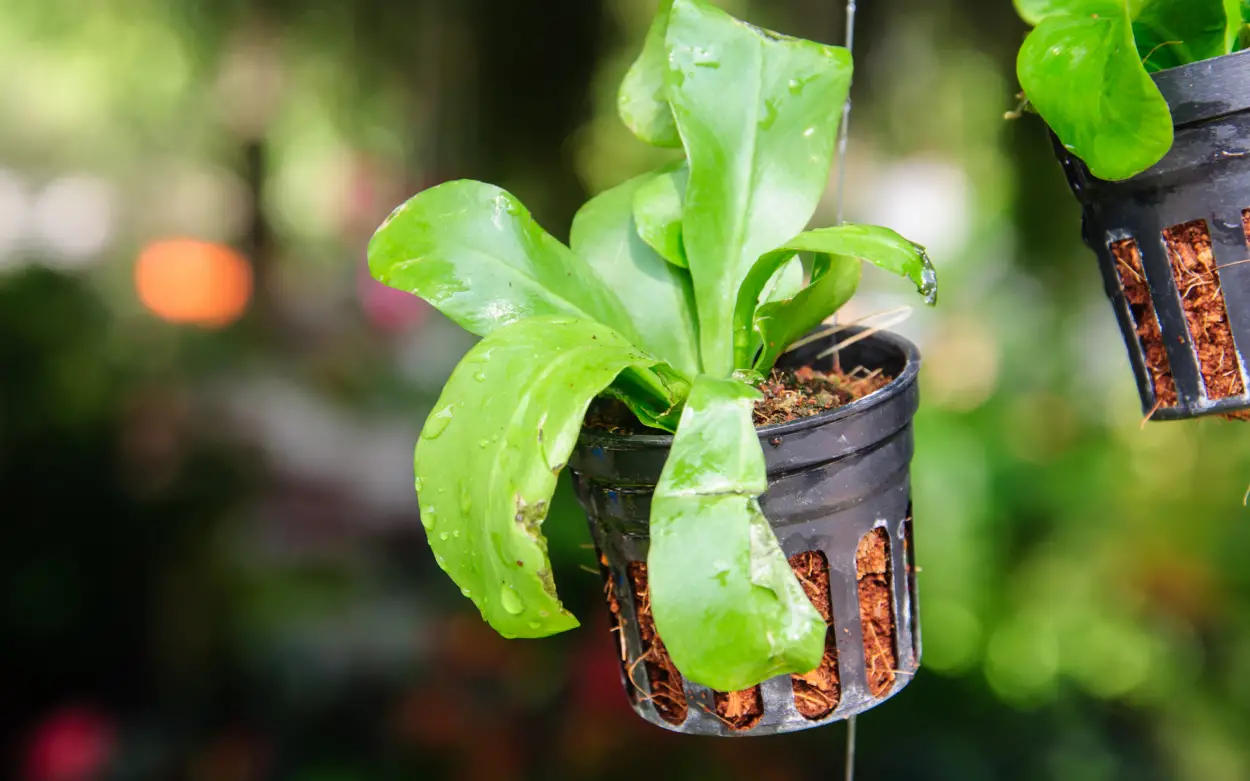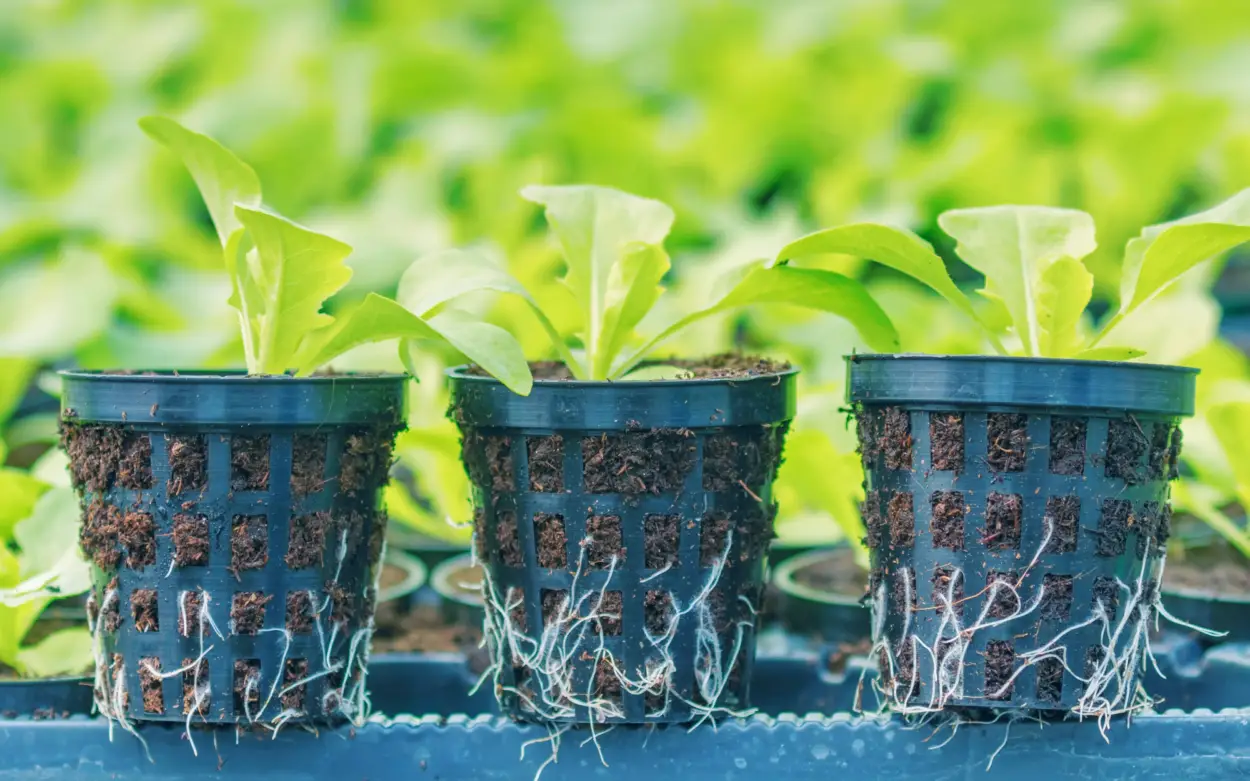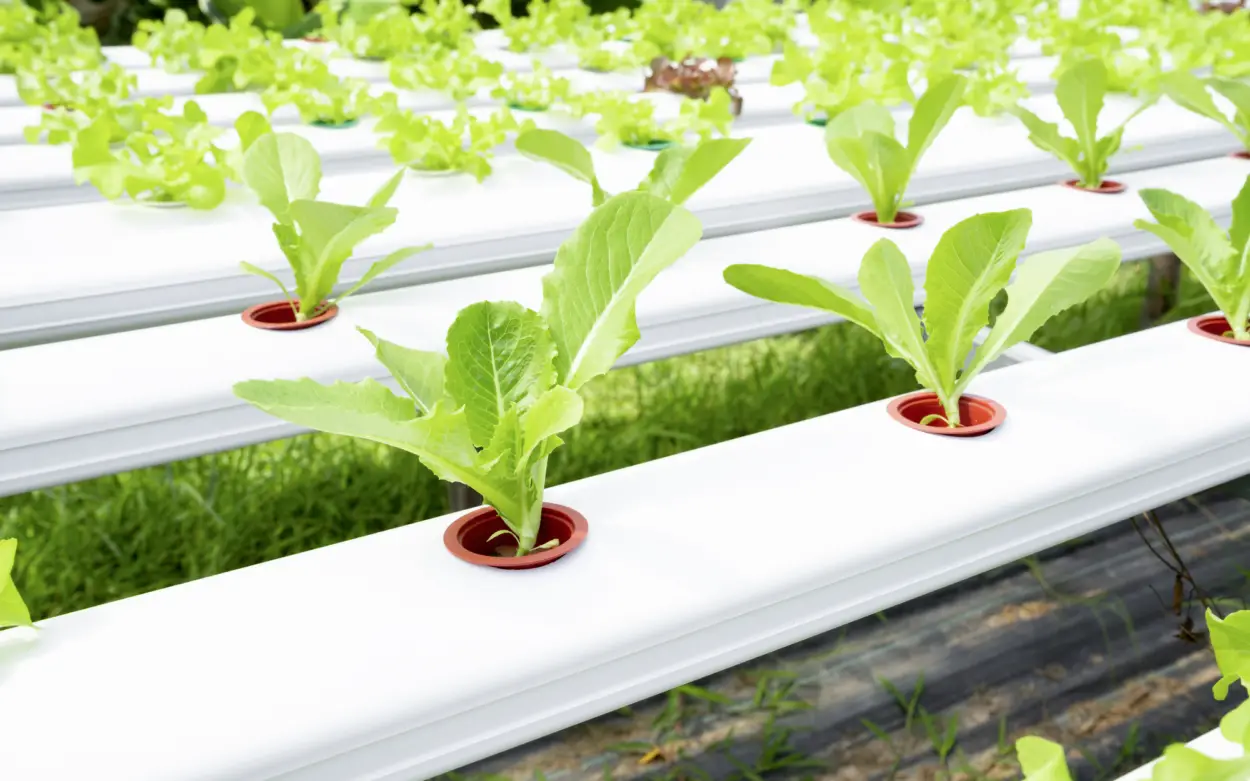How to Choose the Best Hydroponic Net Pots for Each Plant or Setup

This post follows our research editorial guidelines.

There are a lot of components to consider when building your system, and net pots are one of the more important ones. They hold your choice of growing medium, and provide a foundation for your growing garden. But how do you choose your pot? What considerations do you have to keep in mind, and are there drawbacks to the wrong choice?

In This post I Will Cover:
What are net pots used for
Net pots hold the growing medium used in your hydroponic system. They range in size from 2 inches to 6 inches in diameter. The correct size to use in your system will depend on the plant you are growing and the type of hydroponic system itself. Many commercial kits require a specific size, while homemade hydroponic gardens are more flexible in their options.
How do Net Pots Work?
All hydroponics involves delivering nutrients to plant roots through the application of a nutrient solution. To do this, the roots must be readily accessible – enter the net pot!
Net pots are small pots designed to hold the heart of the root mass, while the net itself allows the finer roots to spread out beyond the pot itself. Depending on the type of hydroponic system in use, these secondary roots will either float freely in nutrient solution or be treated to periodic treatments through mists or flows of solution.
The net allows the weight of the plant to be carried safely and securely while allowing the roots access to the nutrient solution below. It’s an elegant technique that applies well to most plants and most hydroponic systems.
Why is the Size of the Net Pot Important?
I don’t like walking about in shoes that are too small, and plants won’t do well either if they’re crammed in a pot too small to hold their weight well. Likewise, a pot that’s too large will require the plant to waste energy working its roots out to the solution.
The pot also needs to fit in your system! That may seem obvious, but for commercial setups, it’s really important to get that right. Home-made rigs can be built to accommodate whatever’s at hand, but if you’re working out of a box it pays to get it right.

The Available Sizes of Grow Nets
In general, net pots are measured across the diameter, in inches. This is the distance across the top of the pot from one side to the other, with the measurement traveling exactly across the middle. They typically come in the following sizes.
- 2″ : Tiny but mighty, the two inch pot is a favorite for herbs, lettuces and the like. Many small scale hobby systems use pots this small.
- 3″: Slightly larger than the tiny two, a 3” pot will work well for short season crops with small root systems.
- 4″: The 4” pot is versatile and easy to use. Most small scale crops will do just fine in them, and larger plants will also manage if well tended. Good for growers keen on a range of plants.
- 5″: This is best for plants that take a long time to mature, and for larger systems.
- 6″: For long term plantings and monster crops, the 6” pot provides sprawling roots the room to grow. Great for long lived plants and big rigs.
What About Mesh Size?
It’s also important to consider the size of the slots or cuts in the net pot when making your choice. Wide holes allow fast root growth out of the pot into the area beyond and have excellent drainage. Smaller holes hold moisture better and are good for supporting more shallow-rooted plants. They also work better for loose media like perlite.
Does the Lip Size of the Net Matter?

The lip is a small amount of flat area at the top of the net pot, a bit like a rim or edge. It’s used to secure the pot in place within your hydroponic system.
The more lip your pot has, the more secure it will be in the rig. Narrow lips are easily knocked free, and the last thing you want is a whole row of seedlings heading for a swim in your solution!
Net pots with good wide lips tend to be a bit pricier, but it really is worth investing. Net pots are one of the resuable components, so you’ll be making your life easier in the long run by making sure your pots have good, easy to secure lips.
What is a Net Pot Cover?
A net pot cover (sometimes also called a net pot lid) is a plastic cap designed to sit on top of your growing medium. They typically have a hole positioned in the middle to allow the top of the plant to protrude, and a split to allow installation.
The main draw-card for net pot covers is that they reduce evaporation from the surface of the medium. Much like net pots, they’re re-usable and come in a variety of sizes. You can do without them if you’re working on a budget, and I’ve found that a bit of aluminum foil or cling film will do much the same job.
Selecting the Right Size of Grow Net for your Growing Medium
“The aim of any hydroponic system is to deliver an optimized nutrient solution to plant roots. The method of delivery can often involve some form of growing medium used to anchor the plant, or to provide a matrix which supports nutrient and water accessibility.”
Peter Wootton-Beard, Aberystwyth University, Wales.
Rockwool
Rockwool is a firm, fibrous material that’s typically manufactured in cubes, plugs or sheets. Prefabricated blocks often have their width listed, so choosing a net pot to match is fairly straightforward. It’s just a matter of picking a size that’s best for your rig and your crop.
I also like to use pots that have good flow through, with large cuts and plenty of openings across the bottom, too. Rockwool holds water very effectively, and can be hard to flush if the bottom of the pot is more bucket than basket. Ensuring good drainage will prevent stagnation and root rot.
Expanded Clay Pebbles
I’m a big fan of clay pebbles (also known as LECA or Hydroton). It’s versatile and re-usable, especially since it comes in a number of different grades. Small pebbles have no hassle working their way out large holes! While its less messy than some media, it’s still a pain to fish them back out, so be sure to use a grade of pebble that isn’t going to work its way free.
Peat Moss Sponges
Peat moss grow sponges are best in smaller cups with a tight mesh. Without the right physical support, the material will disintegrate over time and you’re likely to lose parts of it in solution if your net is too large.
Perlite
Like clay pebbles, perlite is available in a number of different sizes or grades. No matter what size basket you have, there will be a grade that suits your crop and your hydroponic setup.
That said, you’ll need to watch the size of your mesh. The smaller the grade, the tighter your net must be.
Which Size Should You Choose Based on the Plants You are Growing

In general, the larger the plant and the longer it will be in your rig, the larger your pot must be. A massive two-year-long pepper experiment will falter in two-inch pots, and your seasonal lettuces won’t really get much chance to make use of a larger one.
Tomatoes
Tomato root systems are robust and don’t need a lot of physical support. They’ll do just fine in smaller two-inch net pots. If you have a particularly large cultivar, a four-inch net pot is good, and you can go even larger if growing in passive systems like Kratky buckets.
Peppers
Like their cousins’ tomatoes, peppers have good sturdy roots that don’t need a lot of fussing. Your choice of net pot will be determined more by the size of the cultivar – dwarf peppers like the Mirasol will need a two-inch, jalapenos may prefer a four and your big babies like a California Bell Pepper are going to fill out a six-inch pot with ease.
Lettuce
While lettuce roots benefit from good support, they are in general quite small plants that rarely outgrow their systems. A two-inch pot is often more than enough, especially for fast growers in active systems. If you’re gunning for some monster icebergs, a three- or four-inch pot is good, and likewise larger greens in passive systems like salad tables often do well with the extra root support a larger cup offers.
Broccoli
There’s nothing quite as rewarding as harvesting a massive head of broccoli, and to do that you need a strong foundation. Give your broccoli space in a good large pot and you’ll be rolling in florets in no time.
Strawberries
Strawberries are a very accommodating, space efficient crop and most varieties will thrive in compact two- and four-inch pots, largely determined by your rig and how long you want to grow them. Grown as an annual, they’ll manage in a two- or three-inch pot, but for multiple harvests go larger.
Choosing the Type of Net for Your Hydroponic Kit
Deep water culture
Deep water culture rigs, especially homemade ones, are extremely flexible in terms of what size pot you choose. Some deepwater setups don’t even require medium at all – instead, the plants are suspended by a ring around their central trunk or stem. Many will use a floating raft made of Styrofoam or lightweight plastic, allowing the whole lot to float on the surface of the nutrient solution.
I prefer to go smaller in deep water culture hydroponic systems. A smaller net pot has a lower rate of evaporation so deep water will stay deeper for longer.
Ebb and Flow
Ebb and flow systems are dependent on good quality medium holding the right amount of moisture between cycles. In general, smaller pots dry out more quickly than larger ones, especially for large-leafed crops like chard or kale. Go a bit larger than needed and you’ll have a bit of buffer.
Nutrient Film Technique
Plants grown in a nutrient film technique hydroponic system rely on a constant thin film of solution that flows across the bottom of a channel. When growing with NFT, you need to pay attention to the specific needs of the plant and not just cram them into whatever fits in your rig. They need to get most of their root mass down into the film, so don’t make it harder for the plants than is needed.
Kratky
Kratky systems, especially homemade ones, are best served with smaller net pots that prevent evaporation of the solution via the media. The entire principle behind it requires the plants themselves to do much of the heavy lifting, and many Kratky designs use the smallest pot the plant can stand. Opt for a smaller net where possible.
Drip System
Plants grown in drip system hydroponics struggle in net pots. This technique relies on precision moisture held in a more absorbent medium and often is set up with no drainage at all. This is exactly the opposite of a net pot, so if you want to use drip consider Dutch buckets or other closed containers.
Wick System
Like drip systems, wick system gardens really don’t do well with net pots. They require moisture to remain in the medium and are better served with buckets or beds. I’ve heard of people growing orchids in wick systems using baskets, so it’s not impossible, but for crops, you’re better off using a different container for your substrate.
FAQ
Are Net Pots Reusable?
Net pots are indeed a reusable component of your hydroponics system. Like any plastic part of your greenhouse setup, they can be cleaned and sterilized between crops.
That said, the nature of the material does tend to break down with use. The light plastics many cheaper pots are made of often doesn’t hold up to repeat cleaning and you may only get a dozen uses out of them.
This is also true of homemade cups. Depending on your material you may only get one or two uses out of the pot before you have to discard it. At least a recycled yogurt tub that has spent six months growing you food has spent less time in landfill. It’s also saved you a bit of money, and cut back on the new net pots entering the waste stream too.
Can You Use Loose Soil in Net Cups?
Loose soil should never, ever be used in hydroponic systems. Many of the big killer diseases are naturally present in soil. Phytophthora, pythium and rhizoctonia are all common in even healthy garden soil, but will make quick work of your hydroponic crops.
Wet soil is also a poor growing medium. It holds moisture erratically, hosts disease and can become compacted or even disintegrate entirely. It really isn’t worth the hassle, no matter how cheap it might seem.
What Can You use Instead of Net Cups?
I love a little DIY – it’s thrifty and environmentally sound! For any home made rig you can use any small plastic cup or tub that has drainage holes cut into it. Dixie cups are popular, but small plastic solo cups, re-purposed yogurt tubs or even fruit cups are the right size for most plants. To do this:
· Clean your cup of any debris, residues or leftover food waste.
· Using a sharp knife, cut regular rectangular holes at intervals similar to those found in net cups. Alternately, a soldering iron can be used to melt holes. Be sure to do so in a well ventilated area if you choose the latter!
· Ensure all sharp edged are filed down. Fine sand paper or even an emery board is good for this task.
· Finally clean your net pot and sterilize as you would other hydroponic components prior to use.
Final thoughts
The right net pot for your hydroponic system is an investment that’s worth researching. It’ll keep your plant secure while allowing it to make the best use of your nutrient solution. No matter what you’re growing and how you want to do it, there’s a net pot out there to suit your needs.

Before you go!
9 Cheapest Alternatives to Hydroponic Rockwool
Hydroponic Strawberries: the Best Berry To Grow at Home
11 of the best flowers to grow in hydroponics
How Often Should I Change My Hydroponics Water?